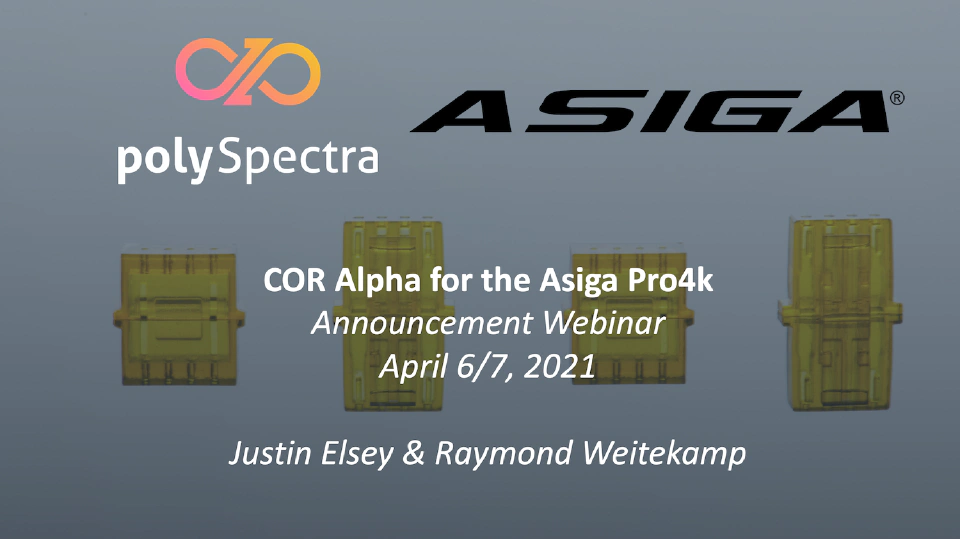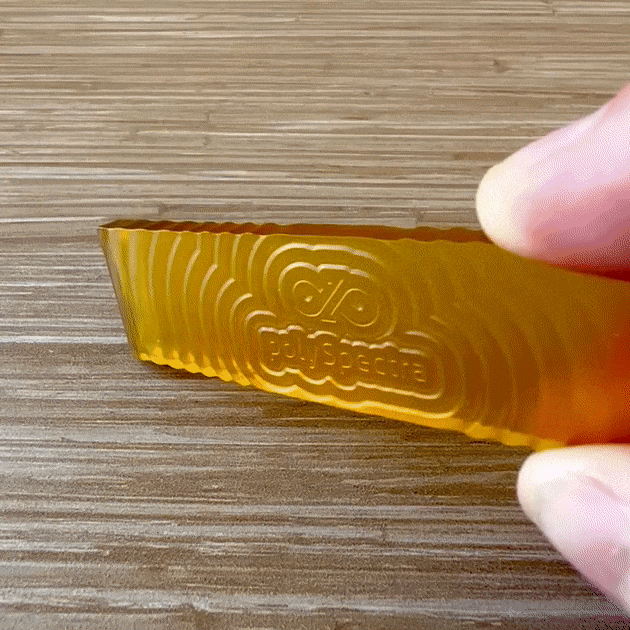This month, we announced a major step forward for making available our actually-production-grade COR Alpha material to more users. polySpectra has partnered with Australia-based Asiga to create a specialized customization for the Asiga Pro4k 3D printer that enables work with COR Alpha.
There are a lot of layers to the announcement, so Asiga Founder and Managing Director Justin Elsey and I hosted a webinar to get into the details.
Here is a sneak preview:
Background
When I did my PhD work in chemistry at Caltech, one of my advisors was the inimitable Bob Grubbs. Bob won the Nobel Prize in 2005, discovering what we now call the Grubbs Catalyst. You may not have heard of the Grubbs Catalyst if you’re not deep in chemistry, but it’s everywhere: drug discovery at every pharmaceutical company, renewable materials research with seed oils – and COR Alpha. His work formed a critical foundation for high-performance durable materials, including what would become our light-activated variation that we brought to stereolithography.
3D printing wasn’t anyone’s first thought for Bob’s work, or for what I was even studying with him. When I first heard about 3D printing at all, I found it boring. From a polymer chemist standpoint, the FDM/FFF extrusion-based 3D printers out there a few years ago were more like a hot glue gun on a stick than something I’d expect to drive actual chemistry innovation. Especially on the photopolymerization side, it seemed like a lot of the chemistry was stuck in the 1950s. When it finally clicked for me that the reason I was so negative about 3D printing was because the materials weren’t there yet. I took that negativity and spun it on its head, and created a company dedicated to solving that.
So here we are at polySpectra, really focusing on what it takes to 3D print durable, end-use parts with an actually durable, end-use material.
A lot of the materials available in stereolithography right now are acrylate- and epoxy-based. Focusing mostly on the former, the limitations pile up pretty significantly with light-activated forms: parts are brittle, they’re not as flexible as you’d like them to be – or if they’re flexible, there’s no tear strength.
Our strength and our weakness at polySpectra is that we’re not using any of the same chemistry that’s been part of the stereolithography story dating back to the technology’s 1980s origins. We have a completely new mechanism that is enabling us to do things that are literally impossible with acrylates.
You can see some of what we’ve been able to achieve in terms of strength in a quick visual test. Check out what happened when we threw one of our parts along with other “engineering-grade” parts made from other 3D printable resins.
The biggest thing is you need to trust the materials you’re working with to get the job done. Look at any other plastic products in your everyday life; you take for granted that your water bottle won’t melt in your car on a hot summer day, or that your phone case will actually protect your phone when you drop it. The main white space we targeted is a rigid polymer that can still have a ductile failure mode, with high impact strength, high toughness, and high heat resistance.
And to 3D print that material, we need it to work within a finely tuned 3D printer.
Asiga Pro4k
Asiga makes DLP-based stereolithography 3D printers. A good machine in this class requires a few specific qualities, primarily centering on the calibration processes and managing the surface forces. A few years ago, Asiga introduced their SPS Technology: Smart Positioning System. SPS is now in every Asiga 3D printer, and the largest in this class is the Pro4k.
Asiga’s machines are based on prediction technology, powered by HD 4k projectors. Scaling that up into a build envelope the size of the Pro4k’s – 176.5 x 99 x 200 mm for the Pro4k65 and 217 x 122 x 200 mm for the Pro4k80 – isn’t a linear process. There was a lot of technology that went into smart positioning for an image projection stereolithography system where precision is key. Asiga absolutely nailed that, and the Pro4k is one of the best machines out there for precision.
Our team has been running Asiga machines for many years now, to power both our R&D efforts and production parts printing service.
polySpectra COR Alpha
We covered some of why we made COR Alpha, but let’s check out what we do and what it does. polySpectra’s founding mission is to create engineering-grade additive materials that help designers, inventors, and engineers make their ideas real.
We see our job as accelerating innovation, in whatever mode is best for the customer. We do design, parts, resin, and partnerships.
Focusing now on the actual resin, we had a clear challenge in front of us. We wanted to address the biggest durability challenges in AM polymers:
- Poor working temperatures
- Brittleness
- Anisotropic properties (Z-strength issues)
- UV-degradation
- Thermal degradation
- Toxicity and leaching concerns
- Poor impact resistance
- Poor tear strength
COR Alpha is our first COR material: it’s a Cyclic Olefin Resin. (Fun fact, the original name for our process is PLOMP: Photolithographic Olefin Metathesis Polymerization.)
The science behind it lies in the Grubbs Catalyst, but in short it’s a tough, tough, tough material. It’s stood up to every solvent we’ve thrown at it; COR Alpha parts have survived conditions exposed to the likes of jet fuel and proton bombardment. It’s never scored less than a perfect zero on 10993-5 cytotoxicity testing.
Cured properties:
- High toughness and ductility
- High working temperature
- Robust chemical resistance
- Weatherability
- Biocompatibility
Liquid resin properties:
- Low shrinkage
- Low viscosities
- Tunable initiation wavelength
- Diverse processing possible
COR Alpha on the Pro4k
COR Alpha works best on 385nm machines – like the Asiga Pro4k. But it does need well-controlled print conditions, and controlling the build environment is one of the main keys to success in working with it. Justin and I go into more detail on the webinar about how we tuned the Pro4K especially for printing COR Alpha: https://geni.us/COR-Alpha-Pro4k-Replay
All Pro4k configurations now have this COR Alpha option available, through Asiga resellers for $34,990.
In Q2 of this year, we’re going to begin shipping COR Alpha to our Early Access customers. In Q3, we’re planning general availability of COR Alpha for the Asiga Pro4k. The fastest way for you to print with COR Alpha in-house is to join our Early Access List.
Get Early Access: https://geni.us/COR-Alpha-Pro4k
To get a better idea of some of the parts you might be able to make using COR Alpha on the Asiga Pro4k, check out the full webinar. Most of the applications we’re involved in are sealed under tight NDA, but we can show off some biomimetic motorcycle parts for EVOL Components and functional medical device components for Respira.Works, for example.
To inspire your creativity, other applications where COR Alpha is a good fit:
- Connectors
- Enclosures
- Housings
- Fluidics
- Brackets
- Jigs & Fixtures
- Tooling
- Gears
- Wearables
Want to know more about COR Alpha for the Asiga Pro4k? The webinar is here – and when you’re ready to take the leap, sign up here to get Early Access to COR Alpha.












